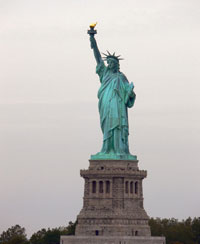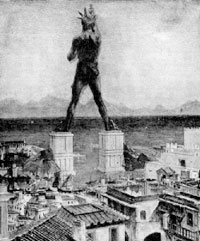Mega malls, indoor gardens, skyscrapers and stadiums—modern man has certainly built a vast array of notable structures. Seeing these modern “wonders,” it is easy to assume he has only been able to achieve this over the past 100 years.
However, thousands of years ago, mankind designed great works of architecture that would boggle the minds of people today. These projects, known collectively as the “Seven Wonders of the Ancient World,” inspired the very buildings we see today.
Once again, let’s look back through the pages of history and examine the most spectacular feats of engineering and design on Earth.
#6 Pharos of Alexandria
In the ancient world, the city of Alexandria was the center of culture and learning. The Library of Alexandria, which housed one of the largest collections of books in the ancient world, contributed to its influence. This widely known depository made the city a destination for scholars, historians, artists and architects, giving Alexandria the title “the birthplace of all ancient wonders.”
Along with this cultural attraction, the city also boasted great economic influence since it was the largest port in the Greek world. Situated on the southern shore of the Mediterranean Sea during the reign of Alexander the Great, Alexandria acquired legendary wealth, which enticed travelers and sailors to visit.
To guide ships into its busy port, King Ptolemy I commissioned a lighthouse to watch over the coast. His son Ptolemy II completed the structure. Called the Pharos of Alexandria, it was over 400 feet tall—the first true skyscraper!
Famed Greek designer, Sostratus, oversaw construction of the massive building. He used solid granite, limestone and other stone blocks held together by lead mortar to solidify the joints and insulate them from the sea below.
While the exact form of the structure is unknown, scholars agree that it was made of three distinct sections, with each diminishing in size toward the top. The base was tall, sloped and rectangular, making up the majority of the structure’s height, and enabling it to brace against the Mediterranean’s waves. The midsection was octagonal and sat in the middle of the base. The top was an open cylinder with a furnace perched on the top. The lighthouse took over 12 years to construct and was the longest-standing wonder behind the pyramids at Giza.
A symbol of power for the city, the Pharos also had a functional purpose of guiding ships safely to port. The three-story furnace situated at the top level burned continuously. The great fire reflecting off mirrors created a beacon that could reportedly be seen for almost 50 miles. Alchemists also created a special brew of tree sap, wood, oil and animal fat—similar to modern day napalm—to keep the fire burning bright at all times. In order to feed this fire, spiral transport ramps wide enough for several men and donkeys lined the interior walls allowing a steady supply of fuel to reach the top.
Much of what we know about the Pharos was documented by Muslim historians. During the Islamic classical period, the tower was used as a minaret, which is used to call Islamic adherents to prayer.
In AD 1303, a massive earthquake brought the Pharos down, crushing much of the city. Debris rolled into the sea, where it remained for 700 years until researchers identified it in the early 2000s. Its intricate detail and the sheer size of the stone blocks prove it was the Pharos.
These blocks were gigantic! A single lintel, or doorway beam, weighed 75 tons. This is equivalent to a Boeing 757 transport airplane! Due to the slender form of the tower and the narrow island, most historians cannot fathom how ancient peoples could have built such a structure.
To this day, it is unclear how the blocks were placed on the top levels or how the structure withstood the wind and waves from the Mediterranean. But the building’s form gives us a clue.
The lighthouse’s outside walls, also called the bearing walls, supported the weight of the building above it. As the three major sections diminished in size, it was easier for these bearing walls to transfer weight to the bedrock beneath.
Modern designers often borrow the structural principle of using a stepped form to create a solid base. Even many early Islamic minarets followed the three-sectioned form of the Pharos. Iconic structures such as the Empire State Building in New York City and the Petronas Towers in Kuala Lumpur, Malaysia, use this geometric form.
While lighthouses are symbolic in seafaring today, for thousands of years, the Pharos was the standard for lighthouses. The image of a tower with a light atop it derived from this first wonder. Even the word “pharos” is the root word for “lighthouse” in most Romance languages, such as phare in French and faro in Italian and Spanish.
#7 Colossus of Rhodes
After the death of Alexander the Great, his four powerful generals divided his kingdom into four regions.

Source: RCG

Source: Getty Creative Images
General Ptolemy I was allotted the small Mediterranean island nation of Rhodes, which controlled many of the seaports in the Mediterranean Sea. Jealous of General Ptolemy, another general, Antigonus, who was determined to control sea routes, immediately attacked Rhodes.
The siege of Antigonus was no match for Rhodian defense. After holding out for several months, Ptolemy’s army crushed the war force of Antigonus—and Rhodes declared victory!
Wild with exuberance, the Rhodians, skilled in the creation of bronze statues, decided to honor their patron god Helios, a pagan deity of the sun, by making the largest statue ever attempted.
To build such a work, Chares of Lindos, a master statue maker, was chosen to erect a colossus. His goal was to create a statue that could be seen for miles and would tower above the island. For construction, Chares gathered spoils, including war machines from the fallen army, to be refashioned for the project. The estimated cost of the colossus was 300 talents—or roughly the price of 300 large warships!
The initial designs of Chares called for a statue 60 feet tall, but for shock value, he doubled the dimensions. Setting to work immediately, Chares cleared the harbor’s edge, making way for the foundation and the tremendous amount of bronze necessary for construction. Workers dug dozens of smelting pits so that all pieces could be created onsite, and poured bronze molds at the foot of the statue. They used hundreds of rivets to fasten the statue’s bronze skin together.
Chares devised a skeletal structural system, which could flex separately from the heavy outer layer, to support the tall and slender figure from the effects of wind and ground tremors. The interior frame was made of wood and iron, and was anchored by heavy boulders in the feet and ankles.
The skin consisted of handcrafted bronze panels, with each piece roughly the size of a man. In order to reach the 120-foot statue’s head, workers mounded earth around the figure, forming a spiral ramp to the top. At its completion, the figure comprised 225 tons of bronze and took 12 years to complete.
As a finishing touch, a crown of gold with rays pointing out to sea, which reflected the rising and setting sun, was placed on the statue’s head.
According to some legends, the legs of the colossus straddled the harbor (as pictured above). Most modern designers, however, feel this is unlikely.
Just 56 years after completion, in 226 BC, the statue collapsed. An earthquake broke the figures’s ankles, causing it to topple onto the city below. It was not until historians discovered the remains that it was officially named one of the seven wonders of the ancient world.
However fantastical the image of a 120-foot statue standing watch over a harbor may seem, 2,000 years later, modern-day builders Frederic Auguste Bartholdi and Gustave Eiffel borrowed from the exact concept of Chares to construct the Statue of Liberty, which now stands guard over the New York Harbor.
Instead of using wood or boulders, engineers built a skeletal metal frame, and braced copper plates to the hollow inner core of the superstructure with iron and steel, grounding the statue in a foundation of steel and concrete.
Standing only slightly taller than Helios at 151 feet, the Statue of Liberty draws heavily from the ancient wonder’s pose. She gazes over the harbor, wearing a crown of the sun’s rays and raising a torch high in the air.
End of the List
The seven wonders of the ancient world encapsulate mankind’s creative genius thousands of years ago.
It is easy to think, given today’s technology, that they were limited in their imagination and ability to create mind-boggling monuments. Yet, by studying history, we realize just how much they progressed—even without the incredible tools of today!
The ancients determined to build the impossible, and pioneered concepts that have stood the test of time. In many ways, our society would not be the same without their achievements.
The current list includes only seven wonders, but the briefest scan of our world today reveals that there no doubt could be many more projects added to the list.
Continue exploring these other “wonders” yourself and uncover the stories of the ancients who overcame great odds to form the cornerstones of modern buildings today!


















